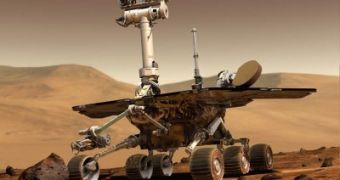It's called OPRA (Optical Probe for Regolith Analysis) and it will literally dig its way through Martian soil to analyze the layers below the surface in their home.
Researchers at the Arkansas Center for Space and Planetary Sciences in partnership with Space Photonics Inc. received a $403,000 grant from NASA, through its Planetary Instrumentation Development branch, to create an optical probe that will be used to determine the composition and amount of ice beneath the surface of a planetary body on the spot, by poking the lower layers of the soil.
"When we look out at these places, we only see the surface, and we wish we could see what lies beneath," said said Rick Ulrich, professor of chemical engineering and principal investigator for the project. "Those layers contain the timeline of the solar system's history."
This new tool will help researchers answer questions that have been around ever since planetary bodies were discovered. And it will do it operating at the base of a rover, driving a spike into the soil. The spike, which may be anywhere from one to four feet long, will contain several dozen quartz windows along its length with fiber optic cables connected to an infrared spectrometer back in the rover, which will provide spectral analysis as a function of depth. Because all the electronics will be isolated in the rover, there will be no heat source to alter the possibly frigid interior of the planetary body.
It will rely mostly on its infrared sensors to provide it with the information on the kind of rock, its chemical composition, the amount of water in the rock and the arrangement of the molecules. By analyzing the compositions of different layers, the researchers can peel back time and look at the geologic history of the planetary body.
"OPRA will analyze these layers without disturbing them," Ulrich said. "We'll get composition versus depth at every layer."
If the new probe lives up to the expectations during the experiments with simulated Mars soil, it will wait for NASA to consider for a mission, and it could be in space in 4 to 6 years. "We envision that this will work on Mars, the Moon, comets and asteroids," Ulrich said.

 14 DAY TRIAL //
14 DAY TRIAL //